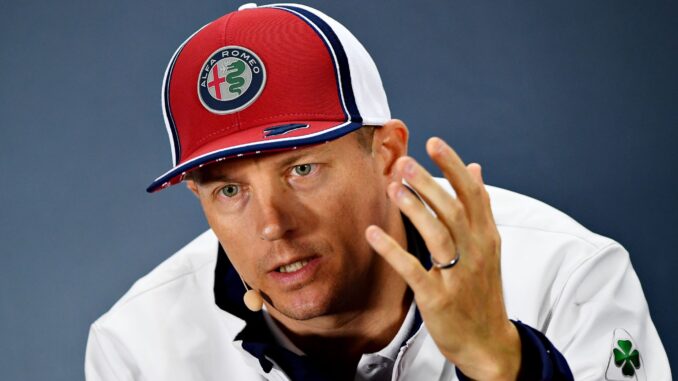
BREAKING: Kimi Räikkönen Explains Why He Made the Decision to Leave Sauber – Two Powerful Reasons Behind His Exit
In a stunning revelation that has sent ripples through the Formula One community, legendary Finnish driver Kimi Räikkönen has finally broken his silence on why he decided to leave Sauber—a team that played a significant role in both the beginning and final chapters of his illustrious F1 career. Known for his ice-cold demeanor and minimalistic interviews, Räikkönen took a rare step by sitting down for an in-depth conversation to shed light on what he calls “two very specific reasons” behind his departure from the Swiss-based racing team.
With his trademark blunt honesty, the 2007 World Champion clarified that the decision wasn’t made overnight, but was rather the result of accumulated frustrations and thoughtful reflection. For fans and pundits alike, Räikkönen’s insights not only provide clarity on his Sauber exit, but also offer a poignant glimpse into the complexities of F1 team dynamics, loyalty, and personal legacy.
A Bond With Sauber — Revisited and Reconsidered
Kimi Räikkönen’s relationship with Sauber is deeply rooted in history. It was with Sauber that he made his Formula One debut in 2001, astonishing the motorsport world with his speed and composure despite having only 23 car races under his belt prior to joining. His rise was meteoric, and he was quickly snapped up by McLaren just one season later. Yet, his bond with the Swiss outfit remained special—so much so that he returned to the team in 2019 when they were rebranded as Alfa Romeo.
His return was initially greeted with optimism. For the team, having a former World Champion brought experience and credibility. For Räikkönen, it was a full-circle moment—a chance to compete in a more relaxed environment without the relentless pressure of championship-contending teams like Ferrari or Mercedes.
However, the recent seasons were not as fulfilling as expected. Sauber struggled with performance inconsistencies, management shifts, and limited development progress, factors that gradually wore down the notoriously unbothered Finn. And now, Räikkönen has finally laid out exactly why he chose to walk away.
Reason 1: Lack of Technical Progress and Competitive Vision
The first reason Räikkönen highlighted was Sauber’s lack of technical evolution and strategic ambition.
“Formula One is not just about driving fast. It’s also about where the team wants to go,” Räikkönen said. “In the last couple of years, I didn’t see the steps forward that I expected. The car wasn’t improving at the rate we needed. You can accept some struggle, but not stagnation.”
Throughout the 2022 and 2023 seasons, Sauber remained in the lower midfield, often battling just to get into the points. According to Räikkönen, the development curve was far too flat compared to rival teams. Despite the team’s acquisition of top-level engineers and increased funding via sponsorship deals, their on-track performances failed to reflect those internal investments.
He explained that constant issues with aerodynamics, tire degradation, and qualifying pace became recurring frustrations. More importantly, he felt that the team wasn’t aggressively pushing the envelope with new technology or innovation, something crucial in today’s hyper-competitive F1 climate.
“Other teams were making bold choices with their car designs. We were too conservative,” Räikkönen added. “I told them we needed to try more, risk more. But it was like shouting into the wind.”
This lack of hunger for risk, in his view, signaled a fundamental misalignment with his own values—even at this late stage in his career.
Reason 2: Management Instability and Internal Politics
The second—and perhaps more personal—reason behind his departure was the growing discontent with internal politics and leadership instability within the Sauber organization.
Over the last few seasons, Sauber-Alfa Romeo experienced several shifts at the top level, including changes in team principals, technical directors, and strategic advisors. While change is not uncommon in Formula One, Räikkönen suggested that the turnover led to inconsistent decision-making and communication breakdowns.
“It’s hard to work when you don’t know who’s really making the decisions,” he said bluntly. “One day you’re talking to one boss, the next day it’s someone else. That’s not how you build a strong team.”

He further pointed out that decisions on car development, race strategy, and even staffing felt disjointed and reactionary. According to him, there were moments when driver feedback—his own and that of his teammate—was dismissed or diluted in the chain of command.
Räikkönen stopped short of naming individuals, but hinted that several key figures “brought ego rather than engineering” to the team. In an organization that should be driven by data, performance, and trust, he saw too much emphasis on image and internal positioning.
“I’ve been in F1 long enough to smell when the air is not clean,” he said with a slight smirk. “And at Sauber, towards the end, it wasn’t.”
Reflecting on His Departure — No Regrets, No Bitterness
Despite these reasons, Räikkönen maintains that he doesn’t harbor any bitterness. On the contrary, he expressed deep appreciation for many of the engineers, mechanics, and support staff at Sauber, whom he called “the heartbeat of the team.”
“There are very good people there, hardworking and passionate. It’s not their fault things didn’t go well. But sometimes you need to step away when it’s clear the road isn’t leading where you want.”
His comments also made it clear that his decision was not based on retirement fatigue or lack of interest in racing.
“If I had a car that gave me a shot at something meaningful, I’d still be driving. But I’m not here to fill space on the grid. I want to enjoy what I do, not just survive it.”
What’s Next for the Iceman?
When asked what lies ahead, Räikkönen was—as always—coy and noncommittal. He emphasized that he would continue to spend time with his family, possibly dabble in motorsport-related projects, and perhaps even mentor young drivers in the future.
Interestingly, he didn’t rule out a return to Formula One in a non-driving capacity. “Never say never,” he said with a wry smile.
Fans and insiders are already speculating that Räikkönen could take on a consultancy or ambassadorial role within the sport. His experience and insight are unmatched, and several teams would likely jump at the opportunity to have him onboard, even in a part-time capacity.
Final Thoughts: A Farewell on His Own Terms
In the end, Kimi Räikkönen’s exit from Sauber is emblematic of the career he has built—decisive, straightforward, and grounded in principle. Unlike many athletes who overstay their welcome, Räikkönen has always known when to move on, guided not by contracts or endorsements, but by instinct and personal clarity.
His explanation, rooted in a desire for competitive integrity and professional respect, reinforces why he remains one of the most respected figures in the sport. Whether or not we see him again on an F1 pit wall or podium, one thing is certain: Kimi Räikkönen leaves Sauber not with fanfare or fireworks, but with the same quiet dignity and iron resolve that defined his entire racing career.
Leave a Reply